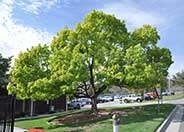
Common name:Camphor Tree
Botanical name:Cinnamomum camphora
This beautiful evergreen tree has glossy foliage that is light green in color. The new foliage comes in with a tinted red color. Eventually, this tree becomes quite large in size (50'-60' tall and 60' wide).
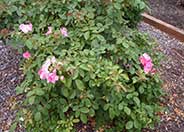
Common name:Shrub Rose
Botanical name:Rosa Shrub varieties
The dark green, heavily veined leaves of this bushy shrub are strong support for the pure white or pink, nearly double flowers it produces. This is a very tolerant, heavily scented plant with an impressive fall color. Also, large hips appear intermittently with this plant.
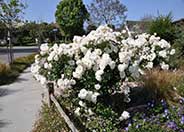
Common name:Iceberg Floribunda Rose
Botanical name:Rosa 'Iceberg'
This is a shrub rose (there are climbing varieties) with an abundance of fragrant, medium sized, white blooms. It is one of the most popular roses and very tough.
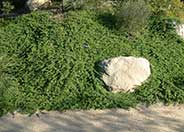
Common name:Ground Cover Myoporum
Botanical name:Myoporum parvifolium
This great ground cover will grow 9" high and 9' wide and does well in partial or full sun with moderate watering. It produces delicate white flowers that bloom in summer and are surrounded by tiny, bright green leaves.

Common name:California Sycamore
Botanical name:Platanus racemosa
The California Sycamore is a fast growing deciduous tree that reaches up to 40'-50' high. It tolerates heat, smog, and drought conditions as well as moist conditions; it is native to riparian areas. It has interesting mottled bark when the tree is bare in winter.
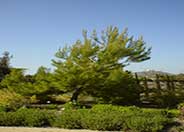
Common name:Aleppo Pine
Botanical name:Pinus halepensis
Aleppo Pine (Pinus halepensis) is a Mediterranean native tree with an upright growth habit, reaching up to 60’ tall and 40’ wide. This tree is often planted in California parks and gardens because of its drought tolerance and its natural vertical shape. This tree is too large for small gardens, but it would be appropriate in medium-to-large gardens that have the space to support it. Its natural, upright growth habit makes it very low maintenance, requiring almost no shaping or pruning when it is young. Once it has been in place for a few years, the pruning should be left to a licensed arborist to keep the tree looking and performing at its best. This tree should be planted at least 10 feet away from any hardscape areas, 30 feet from structures such as houses and buildings, and not near any powerlines. Shrubs and perennials should be planted about five feet away from this tree. It should be irrigated for about 45 minutes once a week when using most in-line drip irrigation systems. It is not recommended for fire-prone areas. Visit the Orange County Fire Authority for more information.
Designer: Barbara Lentz
Photographer: GardenSoft
Maintain a two to four inch layer of mulch on the soil surface to reduce weeds, infiltrate rain water, and reduce compaction.
Remove irrigation water and fertilizer from areas where you don't want weeds to grow.